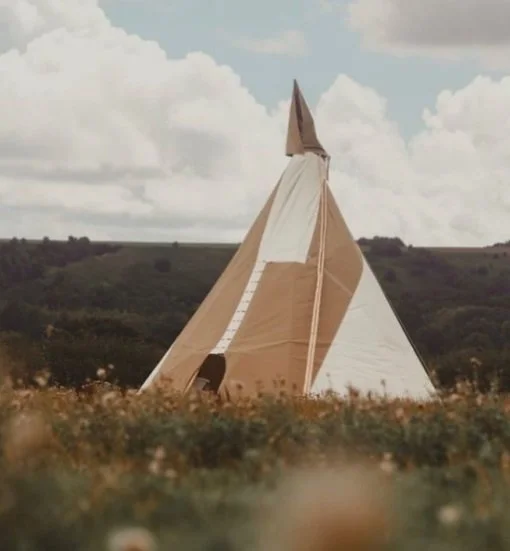The Contemporary Tipi
Tipis are designed to be durable, portable, and in harmony with the natural environment. The conical shape, made from wooden poles and (traditionally) animal skins, made for excellent stability and resilience against diverse weather conditions. This deep respect for nature and functionality forms the foundation of the tipi's enduring design.
Modern Materials and Design Innovations: Today's tipis have embraced modern materials while preserving their traditional shape. Instead of animal skins, tipis are typically made with waterproof, rot proof and fire proof canvas.
With tipis now also being made and used in the UK and Europe changes in the design allow for a wetter climate with things such as PVC strips at the bottom of inner liners to protect it from wet ground and keep out water and breezes and of course the modern kite shaped rainhat! These changes make the modern tipi suitable for various purposes, from a family camping trip to a glamping site or festival accommodation.
Sustainable Living and Eco-Friendly Practices: Although polycotton and cotton canvas is not the most sustainable material (we are always looking for suitable hemp alternatives) it is comparatively better than nylon tent fabric and far more durable, we have maintained tipis for people who have had the same canvas skins since the 70’s!
Tipi poles are from managed woodlands and here at MyTipi we plant native broadleaf trees for each tipi we sell, reflecting a commitment to reducing carbon footprints and promoting a more sustainable way of life. This aligns perfectly with the growing trend of eco-tourism and green living in the UK.
The Tipi as a Space for Retreats and Wellness: One of the most popular modern uses of a tipi is in wellness retreats and holistic therapy sessions. The circular shape and the connection to the earth make them perfect spaces for yoga, meditation, and spiritual gatherings. Their versatility allows them to be set up in all sorts of locations, offering a peaceful escape from the hustle and bustle of modern life.
The Role of Tipis in Education and Outdoor Learning: Educators have also found a valuable resource in tipis for outdoor learning and forest schools. The natural, open space of a tipi is ideal for interactive, experiential learning. The tipi, as an outdoor classroom, inspires curiosity and a deeper connection with the environment among students.
Whether you want to use a tipi for sustainable living, an educational setting, wellness retreat, or simply enjoying the outdoors, the modern version of a tipi continues to be a versatile structure.

